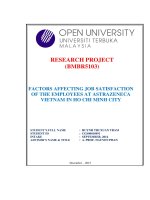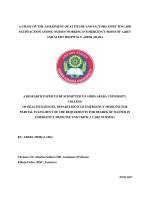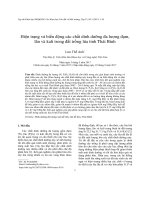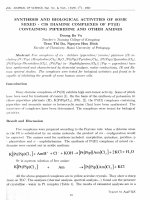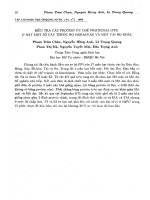DSpace at VNU: Factors Affecting Job Satisfaction of Faculty Members
Bạn đang xem bản rút gọn của tài liệu. Xem và tải ngay bản đầy đủ của tài liệu tại đây (134.78 KB, 6 trang )
VNU Journal of Social Sciences and Humanities, Vol. 29, No. 4 (2013) 24-29
Factors Affecting Job Satisfaction of Faculty Members
Võ Văn Việt*
University of Agriculture and Forestry Ho Chi Minh City,
Linh Trung Ward, Thủ Đức District, Hồ Chí Minh City, Vietnam
Received 01 September 2013
Revised 23 October 2013; Accepted 15 December 2013
Abstract: The purpose of this study is to determine the overall level of job satisfaction, and to
examine factors affecting job satisfaction of faculty members at University of Agriculture and
Forestry Ho Chi Minh City (UAF). A descriptive-correlational survey research design was applied
to answer the research questions and test the study hypotheses. Frequencies, percentages and
appropriate summary statistics were computed for the demographic characteristics, factors of job
satisfaction. Correlation coefficients were calculated to assess relationships between the selected
characteristics. The descriptive analysis of the data indicates that the mean for the overall level of
job satisfaction is 3.97 with a standard deviation of .909. The median and mode score is four. This
is indicative of an above average level of satisfaction; it appears as though the majority of the
employees in the sample are satisfied with the nature of their job. A stepwise multiple linear
regression was performed to determine the best predictor of the dependent variable - overall job
satisfaction. The result showed that our independent variables (fiscal resources, personal growth
and satisfaction, policy and administration) have accounted for 59% of the variance in the overall
job satisfaction of faculty member.
Keyword: Job satisfaction; Job factors; Faculty member.
1. Introduction*
define the basic framework of education.
Today’s higher education institution is an
extremely complex social organization. In
effect, successful schools and universities lay
on the important contributions of effort,
involvement, of all teachers, tutors, or lecturers
- a key resource within higher education
institutions and his major role in achieving the
objectives of the institution. Moreover,
lecturer’s roles are broad and challenging.
They not only have to give lectures, they are
also expected to provide professional
consultations, to conduct academic researches
and to publish their findings so that the
The economic development of nation has
the close relationship with higher education
and education fosters principles of equality and
socialism in the context of Vietnam. Education
forms a support system for talents to excel in
life. It is the backbone of society. Education
gives us the knowledge of the world around us.
Education equips us with all that is needed to
make our dreams come true. Schools and
universities (higher education institutions)
_______
*
Tel: 84-9333948008
Email:
24
V.V. Việt / VNU Journal of Social Sciences and Humanities, Vol. 29, No. 4 (2013) 24-29
university would benefit. They also need to
keep up with new knowledge, new
technologies and new techniques in order to
deliver the best to their students.
As humans, lecturers are also subject to
problems of dissatisfaction at workplace. If
they are not satisfied, they may not be
committed to deliver the best. In addition,
there is a possibility that their job performance
may not achieve the target. This would of
course lead to other adverse effects to students
and finally to the university. Therefore,
lecturer’s job satisfaction is crucial to effective
schools (academic institutions).
The socio-economic changes have put high
pressure on Vietnam’s higher education
system. It led to an increase in social demand
for higher education to prepare students for
jobs in new and modern sectors. When the
demand for skilled labor grew rapidly many
academic staffs left the profession to take up
jobs elsewhere in the public and private sector.
Demand for academic staff in higher education
has been increasing and been expected to
continue to increase. Academic staffs are the
most important group of professionals for one
nation’s future. Therefore, it is crucial to find
out if a large number of academic staffs are
satisfied with their jobs.
Faculty members had varying needs and
motivators and are needed determined. When
these needs and motivators are determined,
school administrators can design and
implement development plan to help meet the
needs of faculty member, which will increase
employee satisfaction and student satisfaction
(Wittenauer, 1980).
The purpose of this study was to explore
the following general questions:
What is the overall level of job satisfaction
of faculty members?
What are the differences in job satisfaction
levels among faculty members based on
biographical variables such as age, gender,
highest degree earned, years of employed?
25
What relationships existed between the
selected job factors and overall job satisfaction
of faculty members?
What measures to improve faculty
member’s job satisfaction would be realistic?
2. Methodology
The research methodology used in the
study was basically quantitative. Specifically, a
descriptive-correlational
survey
research
design was applied. According to Babbie
(1998), the survey method’s purpose is to
generalize from a sample to a population so
that inferences can be made about some
characteristics, attitude, or behavior of this
population. The survey was conducted at the
University of Agriculture and Forestry located
in Ho Chi Minh City, Vietnam. The population
of the study comprises of faculty members
from all departments.
Since only one organization was surveyed,
the researcher’s place of employment,
generalizability from this convenience sample
to employees outside of the target population is
not recommended because of the lack of
statistical random sampling in various
organizations.
Data were collected by using a
questionnaire. The questionnaire consisted of
two independent sections including sociodemographic profile questions, job satisfaction
questions. Job satisfaction questionaire was
adapted from Castillo and Cano’s (1999),
Three Factor Job Satisfaction Scale.
Data were analyzed using the Statistical
Package for the Social Sciences (SPSS®
Version 18.0 for Windows). Correlation
coefficients were calculated to assess
relationships
between
the
selected
characteristics. In this study, Pearson's r,
sometimes called product-moment correlation,
was used to determine the relationship between
interval
variables.
Point-biserial
correlation was used when correlating an
26
V.V. Việt / VNU Journal of Social Sciences and Humanities, Vol. 29, No. 4 (2013) 24-29
interval variable with a nominal variable (a
true dichotomy). Multiple regression is a
multivariate statistical technique that is used
for studying the relationship between a single
dependent variable and several independent
variables. In this study, multiple regression
analysis was also used to test relationship of
OJS with selected job factors.
3. Result and discussion
3.1. The overall level of job satisfaction of
faculty members
The overall level of job satisfaction of
faculty members was assessed by using oneitem statement in the questionnaire which is
“Considering all aspects of my job as a faculty
member, my overall level of job satisfaction
is…”. A six-point Likert-Scale ranging from
very dissatisfied (=1) to very Satisfied (=6)
was used to record respondents feeling about
their job. The value of overall level of job
satisfaction was determined by calculating a
mean score of all responses to the
abovementioned item. Thus, the overall job
satisfaction could range from 1 to 6.
The job satisfaction amongst the sample of
203 faculty members is depicted in Table 1.
The result indicates the mean for the overall
level of job satisfaction is 3.97 with a standard
deviation of .909. The median and mode score
is four. Hence, it may be concluded that the
overall level of job satisfaction of the sample is
moderate. The standard deviation is also not
high, indicating that most faculty members
experience moderate level of job satisfaction.
Table 1: Descriptive statistics (mean, std. deviation) of job satisfaction
Overall level of job satisfaction
Fiscal resources
Policy and administration
Personal growth and satisfaction
N
203
203
203
203
Mean
3.97
2.92
4.12
4.36
Std. Deviation
91
84
80
57
Table 1: Descriptive statistics (mean, std. deviation) of job satisfaction
3.2. The correlation of demographic variables
with the OJS
Pearson’ product moment correlation
coefficients were calculated to measure the
relationship between overall job satisfaction
with demographic characteristics (age, years of
work, educational level, position hold) of
respondents. Significant positive correlation
was found between position of faculty member
and overall job satisfaction (r=.141, p<0.05).
This indicates that the level of job satisfaction
if faculty members increased as the faculty
member’s position in the university increased.
There was no significant relationship between
age and the OJS (r=0.095). This finding is in
line with the study of agricultural education
teachers in Ohio conducted by Cano and Miller
(1992) which does not found a relationship
between age and job satisfaction. But, this is
not in line with in Berns’ (1989) study, he
found that as the age of the teacher increased,
so did his or her overall job satisfaction level.
There was no significant relationship
between educational level and the OJS
(r=0.098). This finding is not in line with
Berns’ study (1989). He reported that a
teacher’s educational level affected his or her
overall job satisfaction level. A teacher with a
master’s degree was more satisfied with his or
her teaching position than a teacher with only a
bachelor’s degree. While, Klein & Maher
(1966), and Motowidlo et al. (1997) found
negative relationship between education and
job satisfaction.
There was no significant relationship
between years of work and the OJS (r=0.079) .
V.V. Việt / VNU Journal of Social Sciences and Humanities, Vol. 29, No. 4 (2013) 24-29
This finding is not in line with Grady’s (1985)
study. He found that as the number of years of
teaching experience increased, overall job
satisfaction increased as well.
Point Biserial correlation coefficients were
calculated to measure the relationship between
overall job satisfaction and gender, there was
also no significant difference found (r=0.079).
27
This finding is in line with the study of Castillo
and others (1999) of Ohio Educational teacher,
they found out that gender was not
significantly related to overall job satisfaction.
But, it is not in line with the study of Herzberg
et al. (1957). Their findings indicate that males
are more satisfied with their jobs, while others
indicate that females are more satisfied.
Table 2: Relationship between OJS and demographic variables
Variable
Gender
Age
Years of work
Educational level
Position hold
3.3. The relationship between selected job
factors and the overall job satisfaction
The relationship between faculty members’
level of overall job satisfaction and the selected
job factors: policy and administration, personal
growth and satisfaction, and fiscal resources
were also calculated using Pearson Product
g
Correlation coefficients (r)
0.079
0.095
0.079
0.098
.141*
Moment Correlations (Table 4.17). The
relationship between overall job satisfaction with
fiscal resources, policy and administration and
personal growth and satisfaction was substantial
with correlation coefficient r = .680, .564 and
.629 (p<0.01) respective.
Table 3: Correlation Matrix for selected job factors and the overall job satisfaction
Personal
Overall level of Fiscal
Policy and
growth and
job satisfaction resources administration
satisfaction
Overall level of job Pearson Correlation 1
.680**
.564**
.629**
satisfaction
Sig. (2-tailed)
.000
.000
.000
Fiscal resources
Pearson Correlation .680**
1
.432**
.484**
Sig. (2-tailed)
.000
.000
.000
Policy and
Pearson Correlation .564**
.432**
1
.723**
administration
Sig. (2-tailed)
.000
.000
.000
Personal growth and Pearson Correlation .629**
.484**
.723**
1
satisfaction
Sig. (2-tailed)
.000
.000
.000
**. Correlation is significant at the 0.01 level (2-tailed)
Table 3: Correlation Matrix for selected job factors and the overall job satisfaction
A stepwise multiple linear regression was
performed to determine the best predictor of the
dependent variable - overall job satisfaction. The
regression model was run with the selected
characteristics in the study, including personal
growth and satisfaction, fiscal resources, policy
and administration. Tests for multicollinearity
indicated that a very low level of
multicollinearity was present (VIF=1.33 for
fiscal resources, 2.26 for personal growth and
satisfaction, 2,13 for policy and administration).
Since the highest variance inflation factor
(VIF=2.26) was under ten, high multicollinearity
did not appear to be a problem.
28
V.V. Việt / VNU Journal of Social Sciences and Humanities, Vol. 29, No. 4 (2013) 24-29
D
Table 4: Multiple regression analysis of overall level of JS on selected Job Factors
The following table 4.24 indicates the result of the regression analysis
Unstandardized
Standardized
Coefficients
Coefficients
t
Sig.
B
Std. Error Beta
(Constant)
-.246 .316
-.779 .437
Fiscal resources
.516
.057
.474
9.052 .000
Personal growth and satisfaction .462
.108
.292
4.270 .000
Policy and administration
.169
.075
.148
2.238 .026
R=.768; R2=.59, Adjusted R2=.583, F=95.3
a. Dependent Variable: Overall level of job satisfaction
Variable
Table 4: Multiple regression analysis of overall level of JS on selected Job Factors.
Let's examine the output from this
regression analysis in the above table. The
constant is not significant indicating total
dependence of overall job satisfaction on the
explanatory variables. The beta value is a
measure of how strongly each predictor
variable influences the criterion variable. The
beta is measured in units of standard deviation.
Thus, the higher the beta value the greater the
impact of the independent variable on the
dependent variable. In this study, a beta value
of .447 for fiscal resource variable indicates
that a change of one standard deviation in the
fiscal resource score will result in a change of
.447 standard deviations in the OJS variable,
given that all other variables in the model are
held constant. The beta value of. 292 for
personal growth and satisfaction variable
indicates that a change of one standard
deviation in the fiscal resource score will result
in a change of. 292 standard deviations in the
OJS variable, given that all other variables in
the model are held constant. The beta value of
.148 for policy and administration variable
indicates that a change of one standard
deviation in the policy and administration
score will result in a change of .148 standard
deviations in the OJS variable, given that all
other variables in the model are held constant.
R is a measure of the correlation between
the observed value and the predicted value of
the dependent variable. In the present study,
this is the correlation between the overall
levels of job satisfaction reported by our
respondents and the levels predicted for them
by our independent variables. R Square is the
square of this measure of correlation and
indicates the proportion of the variance in the
dependent variable which is accounted for by
our model - in this study the proportion of the
variance in the job satisfaction scores
accounted for by three independent variables
(fiscal resources, personal growth and
satisfaction, policy and administration). In
essence, R Square is a measure of how good a
prediction of the dependent variable we can
make by knowing the independent variables. In
this study, we have an R Square value of .59,
we can say that our independent variables
(fiscal resources, personal growth and
satisfaction, policy and administration) has
accounted for 59% of the variance in the
overall job satisfaction of faculty member,
even after taking into account the number of
predictor variables in the model. Particularly,
the analysis revealed that fiscal resources
accounted for 46.2% of the variance in the
level of overall job satisfaction of faculty
members. When personal growth and
satisfaction was added to the regression
equation, 57.9% of the variance in overall job
satisfaction was accounted for. Lastly, when
policy and administration was added 59% of
V.V. Việt / VNU Journal of Social Sciences and Humanities, Vol. 29, No. 4 (2013) 24-29
the variance in the overall level of job satisfaction
of faculty member was accounted for.
Thus, we have linear multiple regression
equation:
OJS=0.516
(fiscal
resources)+.462
(personal growth and satisfaction)+.169
(policy and administration)
4. Conclusion and recommendation
Job satisfaction of employees have always
been important issues and should be taken into
consideration for managers. In a university,
faculty members or lecturers or teachers play an
important role. As teacher determined much of
the student satisfaction and has impact on student
learning, University authorities must devote
greater effort to enhance their capabilities and
must not forget that the success and competing
power of the university depend on committed
and satisfied faculty members.
University authorities need to develop
strategies to deal with the needs of those
teachers who experience less job satisfaction
by pay special attention to items that faculty
member said dissatisfied .
University authorities must be concerned
with the items aligned with the fical resources
job factor when seeking to increase this aspect
of faculty members’ job satisfaction, such as:
revision of faculty members’ salary, increasing
income through subsidization, providing
monies supports for attending workshops,
training and conferences, etc.).
University authorities must also be
concerned with the items aligned with the
personal growth and satisfaction job factor
when seeking to increase this aspect of faculty
members’ job satisfaction, such as: the work
itself and achievement. In order word,
university authorities should promote the
D
29
faculty member by improving policy and
administration, providing better condition for
personal growth and satisfaction and paying
fairly that increase job satisfaction,
commitment.
References
[1] Wittenauer, Martha A. (1980) Job Satisfaction
and Faculty Motivation. Unpublished doctoral
dissertation. Indiana University. Indianapolis.
[2] Babbie, Earl R. (1998) The Practice of Social
Research. 8th. ed. Belmont, CA: Wadsworth
Publishing Company, Inc.
[3] Castillo, J. X., Conklin E. A., and Cano J.
(1999). Job satisfaction of Ohio agricultural
education teachers. Journal of Agricultural
Education, 40(2), pp. 19-27.
[4] Castillo, J. X. and Cano, J. (2004). Factors
explaining job satisfaction among faculty. Journal
of Agricultural Education, 45(3), pp. 65-74.
[5] Cano, J., & Miller, G. (1992). A gender analysis
of job satisfaction, job satisfier, and job
dissatisfier factors of agricultural education
teachers. Journal of Agricultural Education,
33(3), pp40-46.
[6] Berns, R. G. (1989). Job satisfaction of
vocational education teachers in northwest Ohio.
Bowling Green, OH: Bowling Green State
University,
Northwest
Ohio
Vocational
Education Personnel Development Regional
Center.
[7] Klein, S.M., and Maher, J.R. (1966). Education
level and satisfaction with pay. Personnel
Psychology, 19, pp. 195-208.
[8] Lawrence, A. (1972). Individual differences in
work motivation. Human Relations, 25, pp. 327335.
[9] Grady, T. L. (1985). Job satisfaction of
vocational agriculture teachers in Louisiana. The
Journal of the American Association of Teacher
Educators in Agriculture, 26(3), pp. 70-78.
[10] Herzberg, F., Mausner, B., Peterson, R.O., and
Capwell, D.F. (n.d.). Job Attitudes: Review of
Research and Opinion. 1957: Pittsburgh:
Psychological
Service
of
Pittsburgh

